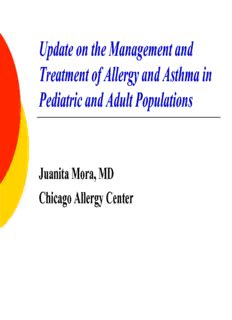
Update on the Management and Treatment of Allergy and Asthma in Pediatric and Adult Populations PDF
Preview Update on the Management and Treatment of Allergy and Asthma in Pediatric and Adult Populations
Update on the Management and Treatment of Allergy and Asthma in Pediatric and Adult Populations Juanita Mora, MD Chicago Allergy Center Disclosures/Conflict of Interest No disclosures. ¡ No Conflicts of Interest. ¡ Learning Objectives Describe what is allergic rhinitis? ¡ Review the Epidemiology of AR ¡ Review the Pathophysiology of AR ¡ Diagnosis and differential diagnosis AR ¡ Assessment and classification of AR ¡ Health effects of Allergic Rhinitis ¡ Management of Allergic Rhinitis ¡ Learning Objectives Review Approach and Treatment of ¡ Asthma Review Asthma Facts and Statistics ¡ Review Advances in Asthma ¡ Pathophysiology Use of Biomarkers to Monitor Therapy ¡ Describe the role of spirometry in the ¡ diagnosis and management of Asthma and EIB Learning Objectives Dicuss Physician Concerns when choosing ¡ ICS therapy. Review ICS to OCS conversions as a tool ¡ towards showing low systemic biovailability and lower chance of systemic side effects A paradigm shift: anti-cholinergic therapy ¡ in asthma Treatment of severe asthma: ¡ Omalizumab (Xolair) l Anti-IL-13 Therapy (Lebrikizumab) l Anti-IL-5 Therapy (Mepolizumab) l Bronchial Thermoplasty l Abbreviations used in this presentation SABA - short acting beta agonist ¡ LABA - long acting beta agonist ¡ NO – nitric oxide ¡ IL-5 - Interleukin-5 ¡ IL-13 – Interleukin-13 ¡ Th – T-helper cell ¡ Allergic Rhinitis ¡ Allergy can affect different children in different ways Food Allergy Atopic Dermatitis Allergic Rhinitis Atopic or Allergy March Natural sequence of allergic clinical conditions Allergic Childhood Asthma appearing during a certain age period and persisting over a number of years from childhood to adulthood Adult Asthma Atopy is the inherited tendency to develop harmful immune responses to harmless substances Allergic Rhinitis Ø Allergic rhinitis is clinically defined as a symptomatic disorder of the nose induced by an IgE-mediated inflammation after allergen exposure of the membranes lining the nose Ø Most prevalent in Pediatric & Adolescent population Ø Traditionally, classified into Seasonal allergic rhinitis (SAR) and Perennial allergic rhinitis (PAR) Phases of allergy: PINE or MPI Subacute/chronic Rapid Phase Late Phase inflammatory phase Normal Sneezing Blockage “Permanent cold” Watery Discharge Mucous Secretion Involvement of sinuses Itching Loss of smell & taste Histamine Prostaglandins Eosinophils Leukotrienes Neutrophils Neutrophils Chemotactic Factors Mast Cel l
Description: